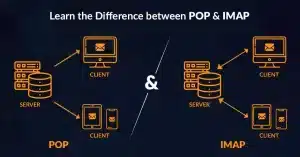The difference between POP3, IMAP, and Webmail

Each email account that you configure on your domain name can be accessed using three different methods. Webmail, IMAP, POP3. The differences between each method are discussed below.
IMAP #
IMAP is an especially convenient way to read e-mail if you use multiple computers. If you check your email on one device at work and another at home, perhaps also a laptop for travel, or you use public computers in a library or computer lab, an IMAP connection is probably the one for you.
Like POP3, mail is delivered to a central server, but the mail client (Outlook, Thunderbird, Vista Mail) doesn’t copy it all at once and then delete it from the server. It is more of an interactive form, where the user can request to display all messages or messages that meet certain criteria. Messages on the central server can be marked with various status tags (eg “deleted” or “answered”), moved to folders either on a local computer or on the server, and remain on the server until explicitly removed by the user. This way messages from other computers can be viewed until they are marked for deletion or downloaded to a folder on your computer.
IMAP leaves messages on the server. It just downloads enough information about the message to display in your email client on your computer. This is what makes it convenient if you use multiple computers where the email is always accessible because it stays on the Shoppe Pro mail server.
POP3 #
The POP3 protocol is designed to support “offline” mail processing. POP3 works best if you’re on one computer all the time. When using POP3, mail is delivered to a central server, and the user uses mail “client” software (Eudora, Outlook, Netscape Messenger, etc.) which connects to the server and downloads all pending mail to the user’s own machine. After that, all mail processing is local to your personal computer.
Once delivered to your computer, the messages are deleted from the mail server (unless you configure your client to leave your mail temporarily on the server.)
One of the main advantages of offline access is that it is less dependent on server resources (meaning less time needed to stay online.)
However, with pop3 email the email will not be available on the server once it is downloaded to your computer unless it is specially configured in the email client. This means that you will not be able to check your email remotely.
The Leave mail on server option in POP3 is designed to be a temporary, central storage location when using multiple devices. One example of an appropriate use of this feature is to set your local POP3 client to leave mail on the server at work and to set your home computer to not leave mail on the server, allowing you to see your mail at work, but always store your mail at home. Leaving mail on the server in a POP3 system is not designed to be a permanent location for storing messages.
webmail #
WebMail provides full access to your mail without downloading any mail to your computer. You can access your mail using your web browser from any computer connected to the Internet at any time. You have the ability to read mail, send mail, create folders for storage, reply, forward, etc. You can also configure rules, set up additional spam filtering, add contacts, and many of the same things you can do in an email client, but all online through a web browser. Since your mail is never downloaded to a computer, the method is ideal for use on public computers. It is convenient for someone who rarely uses the same computer to access mail.
You can access your webmail email account with Shoppe Pro by typing yourdomain.com/webmail in any web browser.
Note: Some of the disadvantages of webmail (versus desktop IMAP/POP clients) are: it takes longer to access messages, few advanced features, and the inability to read or compose mail offline.
The difference between POP3, IMAP, and Webmail





